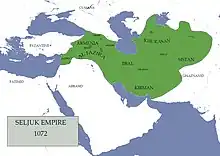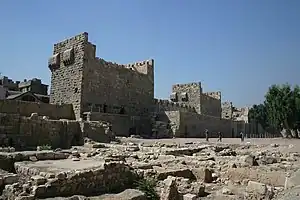Atsiz ibn Uwaq
Atsiz ibn Uwaq al-Khwarizmi, also known as al-Aqsis, Atsiz ibn Uvaq, Atsiz ibn Oq and Atsiz ibn Abaq (died October 1079), was a Turkoman mercenary commander who established a principality in Palestine and southern Syria after seizing these from the Fatimid Caliphate in 1071.
Biography
Around 1069, Badr Al-Jamali, then Fatimid governor (wali) of al-Sham, sent messengers to the Turkomans living in Anatolia asking them to fight against invading Bedouin tribes in his region.[1] The Fatimids had previously hired Turkoman mercenaries which had become one of the dominant forces in the caliphate. At the same time, in the Egyptian heartland of the Fatimid Caliphate, a civil war between the Sudanese and Turkoman mercenaries had begun that was starting to destabilise the Caliphate. According to Ibn al-Jawzi, al-Jamali intended to settle the nomadic Turkomans south of Ma'arrat al Nu'man.[1]

Atsiz, commander of the Turcoman Nawaki tribe[2] or group also known as Nawakiyya, arrived in Syria thereafter and seems to have fought for some time with the Fatimids against the Bedouins. In 1070, with the civil war in the Caliphate still raging, disputes about the financial compensation seem to have led some Turkoman to side with the Bedouin and seek to establish their own principality.[1] The beginnings of the new principality are uncertain, but in 1073 Atsiz was in control of Jerusalem as well as Ramla, the provincial capital of the region. He captured Damascus in 1076, becoming the first Turkoman emir of Damascus, where he began construction of the Citadel of Damascus.

Having established his position in Palestine, Atsiz attempted to invade Egypt in October 1076. Here he had to face Al-Jamali, who in 1074 had become vezir to the caliph Al-Mustansir and stopped the bloody infights between the Caliphate's military.[1] Atsiz advanced to Cairo where he started negotiations with Al-Jamali who in the meantime gathered his troops. Al-Jamali also bribed some of Atsiz' troops and in a battle in February 1077 he was so successful that Atsiz had to flee while one of his brothers was dead and another one had lost one of his arms.[3]
Atsiz defeat led to rebellions in his domain, such as in Jerusalem, which he crushed brutally.[2][4] In 1077 he broke his promise of amān, or quarter, given to the rebels, and after they opened the gates his troops slaughtered an estimated 3,000 of them, including those who had taken shelter in the Al-Aqsa Mosque and only sparing those inside the Dome of the Rock.[4][5][6] Al-Jamali, intenting to profit from the weakness of his enemy, send an army under one his Armenian generals, Nasr Al-Dawla, to confront him. Atsiz appealed to the Seljuks and soon an army under Tutush I, brother of the Great Seljuk sultan Malik-Shah I, marched towards Damascus, scaring off the Fatimid forces. Tutush, however, decided to take control of Atsiz territories and had him first imprisoned, then strangled with a bowstring in October 1079.[1]
Legacy
Atsiz's principality represents one of the many Turkmen state foundations on the periphery of the Seljuk empire such as the emirates of Rum, of Izmir or of the Danishmendids that sprung up during the same period. Atsiz by his conquest of Jerusalem from the weakened Fatimids, along with the 1071 Byzantine defeat against the Seljuk Turks at Manzikert, is quoted as a major cause for the Crusades, as these events created a sense of threat to the Christian holy places, Europe and Christianity as a whole.[7][8]
References
- Dadoyan, Seta (2013). The Armenians in the Medieval Islamic World: Armenian Realpolitik in the Islamic World and Diverging ParadigmsCase of Cilicia Eleventh to Fourteenth Centuries. Transaction Publishers. p. 47. ISBN 9781412848879. Retrieved 7 April 2022.
- Gil, Moshe (1997). A History of Palestine, 634–1099. Cambridge University Press. pp. 409–412. ISBN 9780521599849. Retrieved 23 September 2020.
- ben Joseph Ha-Kohen, Solomon; Greenstone, Julius H. (January 1906). "The Turkoman Defeat at Cairo". The American Journal of Semitic Languages and Literatures. 22 (2): 144–175. doi:10.1086/369565. JSTOR 527656. S2CID 170839031. Retrieved 7 April 2022.
- Cline, Eric H. (2007) [2004]. Jerusalem Besieged: From Ancient Canaan to Modern Israel. University of Michigan Press. pp. 159–160. ISBN 978-0-472-03120-7. Retrieved 23 September 2020.
- Gil (1997), p. 412
- Richards, Donald Sidney (ed., transl.) (2002). The Annals of the Saljuq Turks: Selections from Al-Kāmil fīʻl-Taʻrīkh of ʻIzz al-Dīn Ibn al-Athīr. Studies in the history of Iran and Turkey, Volume 2. RoutledgeCurzon. ISBN 9780700715763. Retrieved 29 July 2020.
{{cite book}}: CS1 maint: multiple names: authors list (link) - Peacock, A. C. S. (2015). Great Seljuk Empire. The Edinburgh History of the Islamic Empires. Edinburgh University Press. pp. 54–55. ISBN 9780748698073. Retrieved 24 September 2020.
- Holmes, Nick (2019). The Byzantine World War. Troubador Publishing. p. 111. ISBN 9781838598921. Retrieved 24 September 2020.
Bibliography
- Başan, Aziz (2010). The Great Seljuqs: A History. Abingdon: Routledge. pp. 85, 88–89. ISBN 978-0-203-84923-1.
- Burns, Ross (2005). Damascus: A History. Abingdon: Routledge. p. 144. ISBN 0-415-27105-3.
- Cahen, Cl. (1960). "Atsiz b. Uvak". The Encyclopaedia of Islam, New Edition, Volume I: A-B. Leiden: BRILL. pp. 750–751. ISBN 90-04-08114-3.
- Greenstone, Julius H. (January 1906). "The Turkoman Defeat at Cairo, by Solomon ben Joseph Ha-Kohen". The American Journal of Semitic Languages and Literatures. 22 (2): 144–175. doi:10.1086/369565. JSTOR 527656. S2CID 170839031.
- Kennedy, Hugh (1994). Crusader Castles. Cambridge: Cambridge University Press. p. 182. ISBN 0-521-42068-7.
- Richards, D. S. (Trans.) (2002). The Annals of the Saljuq Turks: Selections from al-Kamil fi'l-Ta'rikh of 'Izz al-Din Ibn al-Athir. Abingdon: Routledge. pp. 172, 190, 192–193, 197–198. ISBN 0-700-71576-2.